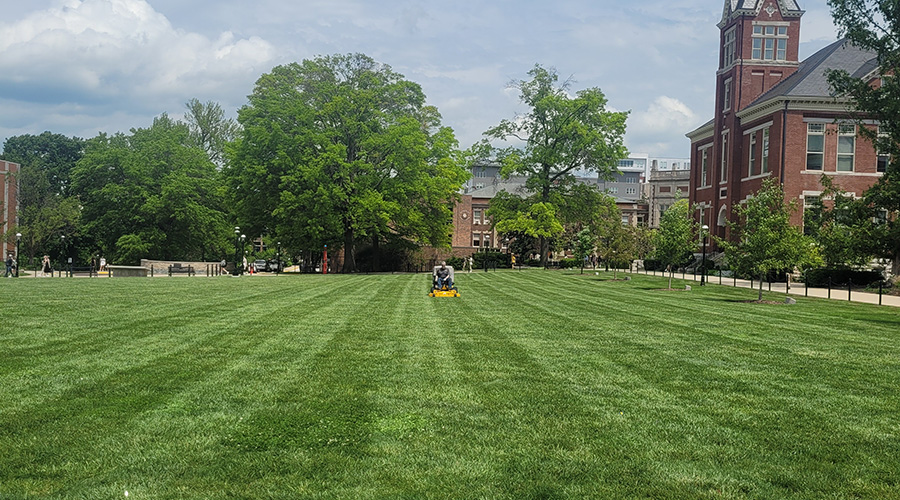Utility Vehicles’ Growing Versatility
Manufacturers monitor customer needs in developing the next generation of these grounds care workhorses
For anyone who still is unconvinced about the expanding role that utility vehicles play in grounds care, James Burnside offers an insight from his visit to the University of Indiana.
“They had one of everything,” says Burnside, product manager for Kubota Tractor Corp., referring to an array of utility vehicles the university uses to handle turf care, material hauling, trash pickup and a series of other tasks. “Each of them had specific tasks they were used for.”
But the array of vehicles was noteworthy in another way: many of them were from different manufacturers, he says. Like many grounds care operations, the university’s had identified needs and found utility vehicles to meet them, regardless of who manufactured them. Manufacturers developing the next generation of vehicles have taken note of the numerous ways grounds care operations use these flexible and reliable workhorses.
“We offer a wide variety of products because there is a wide variety of needs,” says Larry Jones, product manager for Jacobsen, a Textron company.
So while managers specifying and purchasing utility vehicles today might anticipate being overwhelmed by their choices, manufacturers note that if customers look carefully enough, they’ll find the specific vehicle they’re seeking.
Vehicle Evolution
Utility vehicles certainly have come a long way in recent years, largely in response to changing customer needs.
“Customers are always looking for ways to be more efficient, and utility vehicles offer that value,” Jones says.
Says Keith E. Elsam, product manager for utility vehicles at John Deere Co., “The role certainly has evolved over the past 20 years. Beginning with golf carts, which were modified to carry things other than just a passenger and golf clubs, the commercial markets started to understand the lower operating costs inherent with these off-road utility vehicles. Today, a commercial manager has a large assortment of utility vehicles to choose from.”
Among the reasons managers might consider these vehicles over a pickup truck, Burnside says, is that they can fit into tighter spaces, require no registration, aren’t as likely to be driven off the premises, can’t be driven as fast and require less maintenance.
Among the many options now available are four or six wheels, and two-wheel- or four-wheel-drive traction systems. Many manufacturers also offer a host of accessories, from cabs, dump beds, rotary brushes and boom sprayers to vacuums and side-walk sweepers. Increasingly, departments hitch plow blades to utility vehicles for use in snow-removal duty in winter months.
“All of these attachments were out there 10 years ago, but the technology is better now,” Burnside says.
Manufacturers also offer choices in fuel, including gas, diesel or electric power.
“Managers typically are purchasing the engine fuel type most commonly used within their operations,” Elsam says. “Some who have noise-sensitive work environments are utilizing electric vehicles.”
Electric or battery-powered vehicles can work well in light-duty operations and transporting workers. Among their benefits is that they tend to be environmentally friendly, relatively inexpensive and easy to operate. Also, their maintenance is minimal, but they do need to be recharged overnight, which usually provides a full day of power.
“Electric technology has gotten much better,” Jones says, adding that today’s vehicles hold a charge better so they run longer than their predecessors.
Customers, including many universities, are paying greater attention to “green” issues. Electric utility vehicles attract attention because they can help reduce dependency on foreign sources for transportation fuel and reduce toxic emissions. For the same reasons, some universities also use utility vehicles that are powered by compressed natural gas and have installed natural-gas fueling stations.
Gasoline- and diesel-powered trucks have more power than their electric counterparts. They can be equipped with a larger cargo bed and can pull a small trailer.
Although diesel engines can be more expensive up front, they do offer several long-term benefits. They tend to be more fuel-efficient, they require less maintenance, and the price of diesel fuel tends to be lower than unleaded gasoline.
Narrowing the Field
So how does a grounds care manager make the decision to purchase a particular vehicle? Zeroing in on a final choice often is the result of a lengthy research process. As the University of Indiana’s lineup of utility vehicles suggests, managers are becoming more savvy about specifying vehicles that meet specific needs. In some cases, customers enter the process with a very specific purpose.
“They identify what has worn out or is breaking constantly on the utility vehicles they have, and they look for a machine with a better version of that feature,” Burnside says.
Elsam says managers must understand these needs as much as possible before talking with a manufacturer. Among the questions he advises managers to ask about intended vehicle use are these:
-
What should be the top speed of the vehicle?
-
What is the experience level of the operators who will use this vehicle?
-
Will this vehicle be used primarily to complete tasks, as a transport vehicle, or both?
-
On what type of terrain will this vehicle be used — mud, sand, hills, etc.?
-
Is ground or turf compaction an issue?
-
What is the required maximum load capacity?
-
Will the vehicle be used to pull implements? Are there any requirements for low torque?
Price and Beyond
The price of a utility vehicle — or of any large piece of equipment, for that matter — remains a top priority for managers in the market to buy.
“Cost is always a concern in any organization where you have a budget,” Burnside says. “But purchasers have become much more flexible in terms of specifying.” That flexibility includes taking a closer look at equipment features and options, as described above, as well as taking other matters into consideration, Elsam says:
-
Are the purchasers interested in financing or leasing?
-
Do they fully understand the the terms of the factory warranty, specifically what it includes and excludes?
-
Do they know and can they depend on the local dealer and the manufacturer for quick turnaround on both parts and service?
Safety Matters
Manufacturers recommend that customers take a close look at and compare the safety features of any vehicle they are considering. The companies say they have gone to great lengths to install and improve safety features to meet customer demands.
For example, Kubota installed rollover protection on its vehicles to meet mandates from potential government customers.
“That’s what drove us to do it,” he says. “That’s absolutely the reason we did it.”
Adds Elsam: “All managers should mandate that their equipment operators read the operators manual and watch the safety video if available. The manager should make sure the operator knows and understands the vehicle and its limitations.”
Manufacturers say that utility vehicles will continue to evolve based on customer needs, with one overriding priority.
Says Elsam, “Customers are looking for a reliable piece of equipment with minimal downtime.”
Related Topics:











